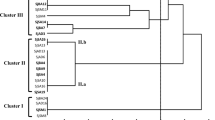Abstract
Using a collection of tropical rhizobia from different species and host plants, we established a high correlation between rhizobia host range, NF TLC profiles, NF structures and nodA sequences. Both techniques based on NF and nod gene analysis could be used to develop a polyphasic approach for the symbiotic characterization of rhizobia.
Access this chapter
Tax calculation will be finalised at checkout
Purchases are for personal use only
Preview
Unable to display preview. Download preview PDF.
Similar content being viewed by others
References
Debellé et al. 1996. The NodA proteins of Rhizobium meliloti and Rhizobium tropici specify the N-acylation of Nod factors by different fatty acids. Mol. Microbiol. 22, 303–314.
Dénarié J, Debellé F, and Promé JC 1996. Rhizobium lipo-chitooligosaccharide nodulation factors: signaling molecules mediating recognition and morphogenesis. Ann. Rev. Biochem. 65, 503–535.
De Lajudie, et al. 1994. Polyphasic taxonomy of rhizobia. Emendation of the genus Sinorhizobium and description of Sinorhizobium meliloti comb. nov., Sinorhizobium saheli sp. nov., and Sinorhizobium teranga sp. nov. Int. J. Syst. Bacteriol. 44, 715–733.
De Lajudie, et al. 1998. Characterization of tropical tree rhizobia and description of Mesorhizobium plurifarium sp. nov. Int. J. Syst. Bacteriol. Bacteriol. 48, 369–388.
Graham, et al. 1991. Proposed minimal standards for the description of new genera and species of root and stem-nodulating bacteria. Int. J. Syst. Bacteriol. 41, 582–587.
Haukka K, Lindström K, and Young JPW 1998. Three phylogenetic groups of nodA and nifH genes in Sinorhizobium and Mesorhizobium isolates from leguminous trees growing in Africa and Latin America. Appl. Environ. Microbiol. 64, 419–426.
Lorquin, et al. 1997a. Sinorhizobium teranga by. acaciae and Rhizobium sp. ORS1001, two taxonomically distant related Acacia-nodulating strains, produce similar Nod factors that are 0-carbamoylated, N-methylated, and mainly sulfated J. Bacteriol. 179, 3079–3083.
Lorquin, et al. 1997b. Nod factors from Sinorhizobium saheli and S. teranga Sesbania-nodulating strains are both arabinosylated and fucosylated, a structural feature specific to Sesbania rostrata symbionts. Mol. Plant Microbe Interact. 10, 879–890.
Lortet, et al. 1996. Nod factor thin-layer chromatography profiling as a tool to characterize symbiotic specificity of rhizobial strains: application to Sinorhizobium saheli,S. teranga, and Rhizobium sp. strains isolated from Acacia and Sesbania. Mol. Plant-Microbe Interact 9, 736–747.
Mergaert, et al. 1997a. Nod factors from Azorhizobium caulinodans strain ORS571 can be glycosylated with an arabinosyl group, a fucosyl group or both. Mol. Plant Microbe Interact. 10, 683–687.
Mergaert P, Van Montagu M, and Holsters M 1997b. Molecular mechanisms of Nod factor diversity. Mol. Microbiol. 25, 811–817.
Quinto, et al. 1997. Bacterial nodulation protein NodZ is a chitin oligosaccharide fucosyltransferase which can also recognize related substrates of animal origins. Proc. Natl. Acad. Sci. USA. 94, 4336–4341.
Ritsema, et al. 1996. Rhizobium nodulation protein NodA is a host specific determinant of the transfer of fatty acids in Nod factor biosynthesis. Mol. Gen. Genet. 251, 44–51.
Schultze, et al. 1995. In vitro sulfotransferase activity of Rhizobium meliloti nodH protein: Lipochitooligosaccharide nodulation signals are sulfated after synthesis of the core structure. Proc. Natl. Acad. Sci. 92, 2706–2709.
Spaink, et al. 1992. Detection and separation of Rhizobium and Bradyrhizobium Nod metabolites using thin-layer chromatography. Mol. Plant-Microbe Interact. 5, 72–80.
Author information
Authors and Affiliations
Editor information
Editors and Affiliations
Rights and permissions
Copyright information
© 1999 Springer Science+Business Media New York
About this chapter
Cite this chapter
Boivin, C., Giraud, E. (1999). Molecular Symbiotic Characterization of Rhizobia. In: Martĺnez, E., Hernández, G. (eds) Highlights of Nitrogen Fixation Research. Springer, Boston, MA. https://doi.org/10.1007/978-1-4615-4795-2_59
Download citation
DOI: https://doi.org/10.1007/978-1-4615-4795-2_59
Publisher Name: Springer, Boston, MA
Print ISBN: 978-1-4613-7172-4
Online ISBN: 978-1-4615-4795-2
eBook Packages: Springer Book Archive




